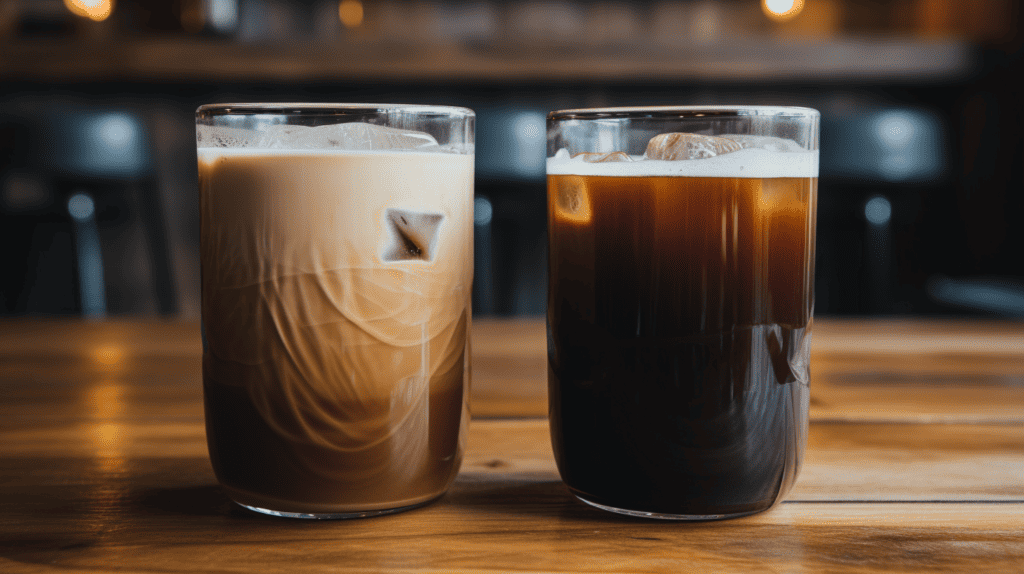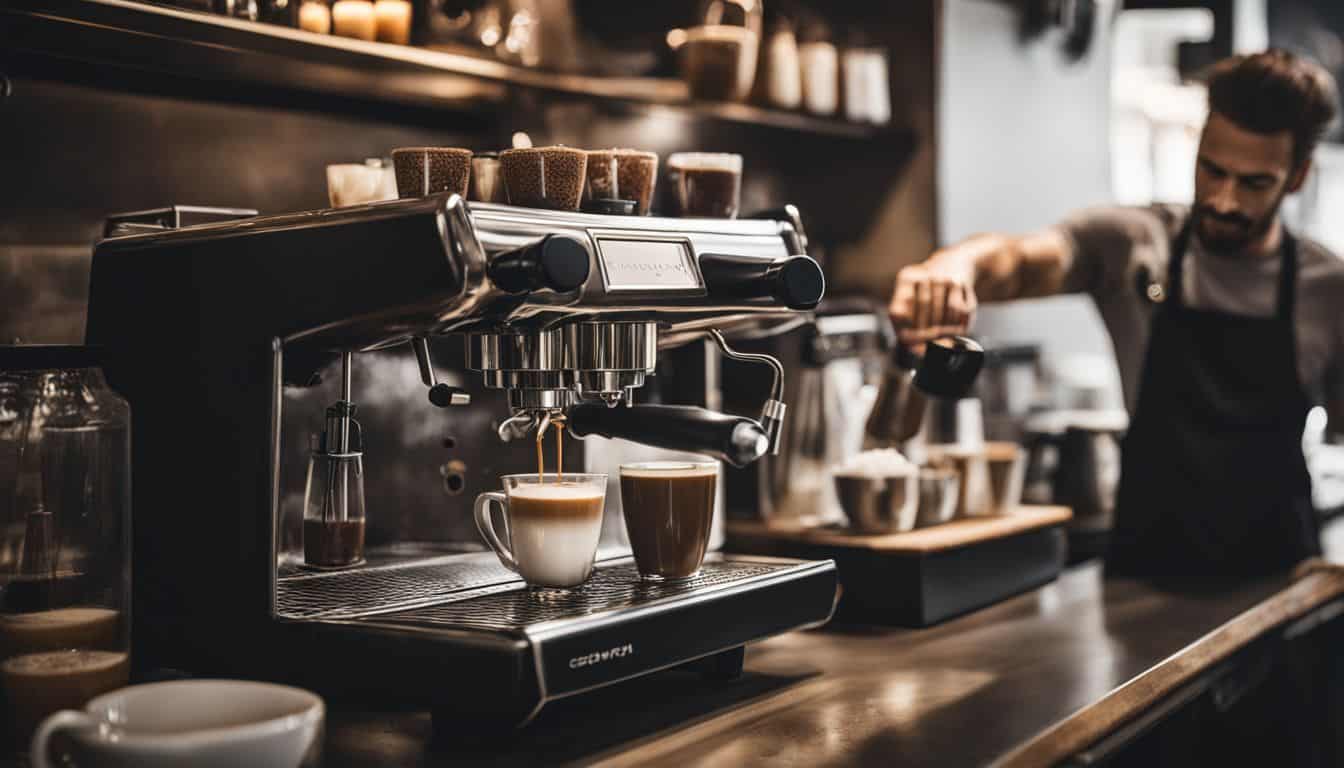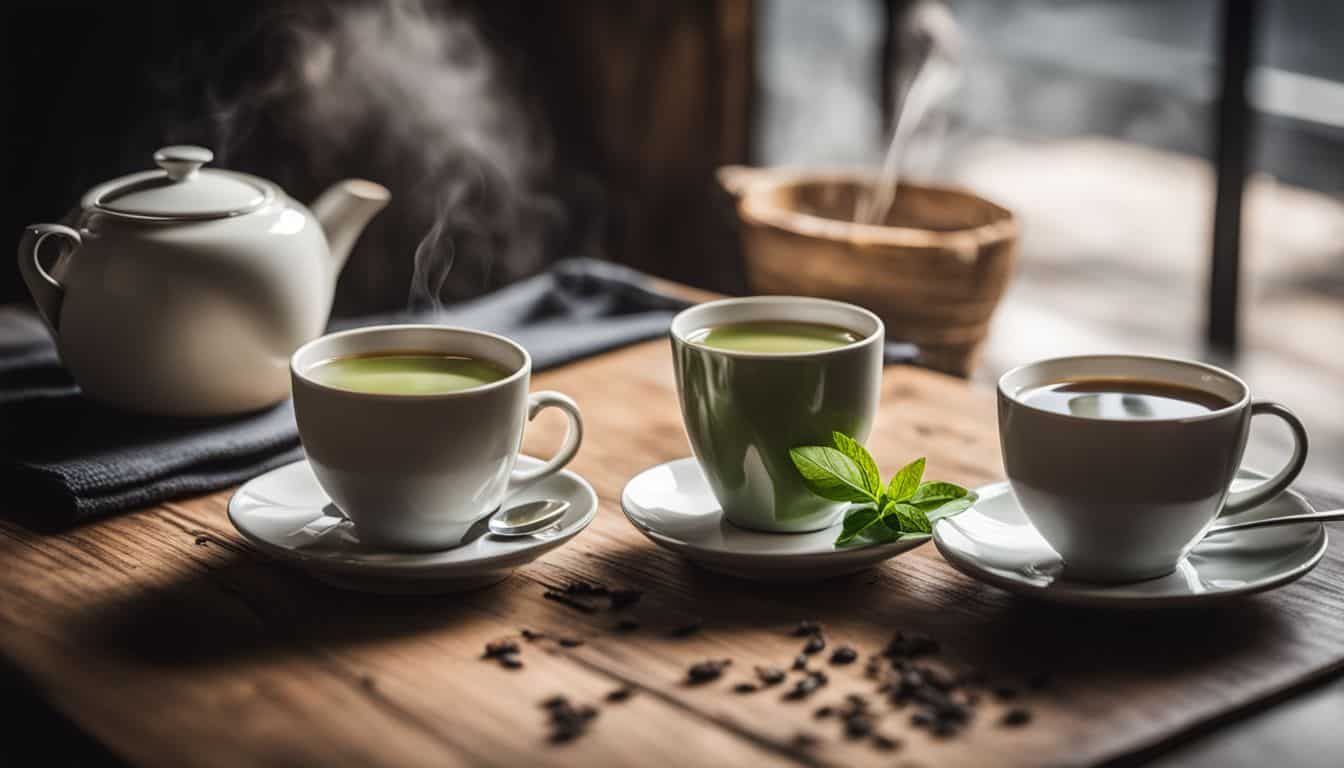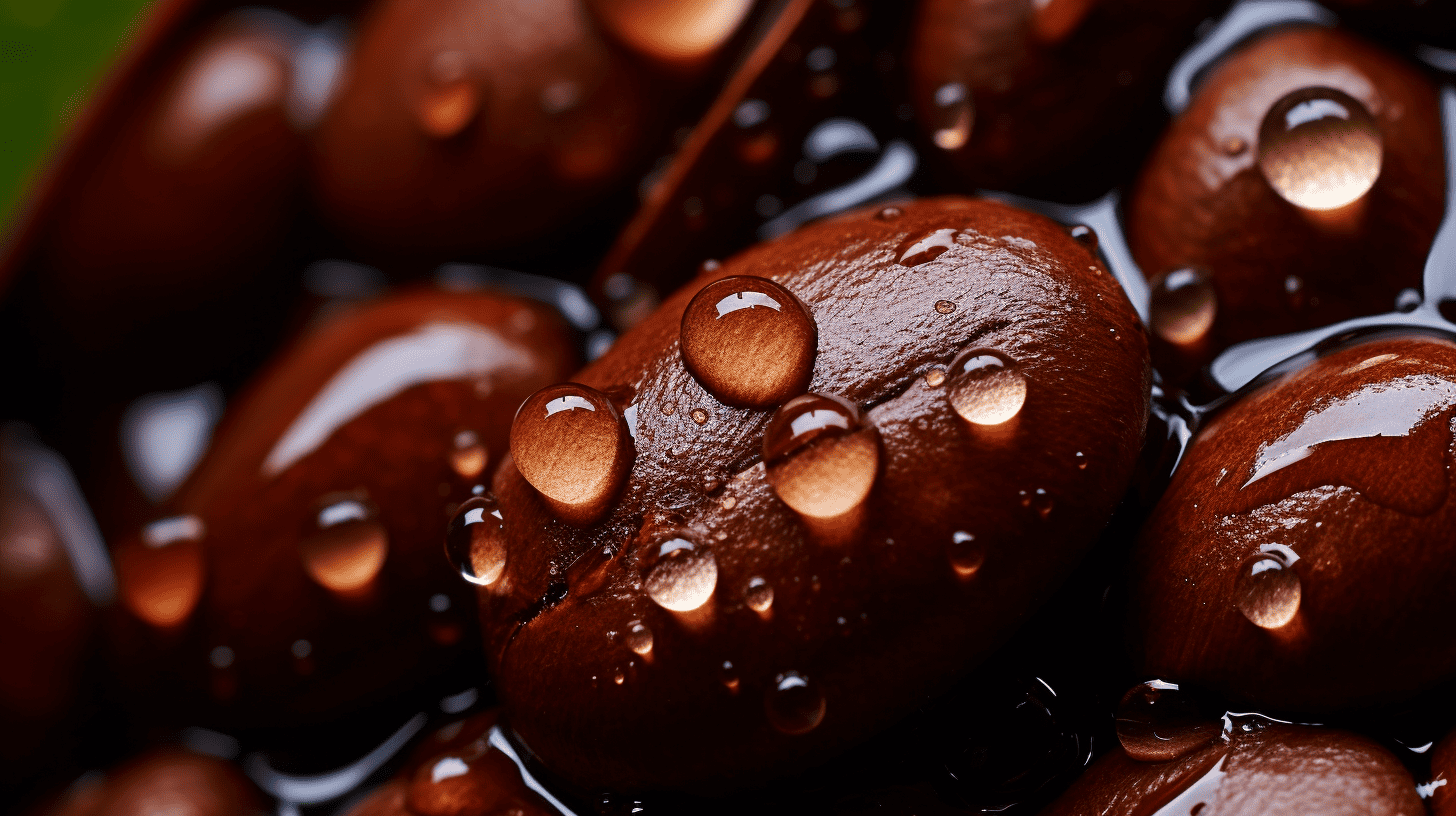You’ve probably stood at a coffee shop counter, staring at the menu and wondering what exactly is the difference between espresso and cappuccino. I know, because I’ve been there too, curious about these two iconic coffee drinks that dominate most menus.
This blog post will help unravel this mystery by comparing every element of these irresistible beverages from their preparation to taste profiles. So dive in with me as we embark on an enlightening journey across the world of espresso and cappuccino!
Key Takeaways
- Espresso is a strong and dark coffee made by forcing hot water through finely ground coffee beans, while cappuccino adds steamed milk and foam to the espresso.
- Espresso has a robust flavor with a smooth texture, while cappuccino has a creamy and frothy texture that balances out the bitterness of the espresso.
- Espresso is served in small cups and enjoyed quickly for its intense flavor, while cappuccinos are larger drinks meant to be enjoyed leisurely with friends or during brunch.
- An espresso shot has higher caffeine concentration compared to a cappuccino due to the dilution from milk and foam.
What is Espresso?
Espresso is a strong and dark coffee beverage, known for its smooth and bold flavor.
Definition and characteristics
Espresso is a dark, robust coffee. It’s made by forcing hot water under high pressure through tightly packed grounds. Bitter in taste, it feels smooth when you drink it. On the other hand, cappuccino uses espresso as its base.
Yet, it pairs this strong shot with warm milk and milk foam on top which gives it a creamy flavor. You may even find some with a light dusting of cocoa or cinnamon for extra taste.
Unlike the small serving size of espresso, cappuccinos are usually larger due to the added milk and foam.
How it is made
Espresso is made by forcing hot water under pressure through packed coffee grounds.
Taste and texture
Both espresso and cappuccino have distinct taste and texture profiles. Espresso is known for its robust flavor, which can be quite bitter. It has a strong, concentrated taste that coffee lovers appreciate.
The texture of espresso is smooth and velvety, with a rich consistency that coats the palate. On the other hand, cappuccinos have a smoother flavor compared to espresso due to the addition of steamed milk and milk foam.
They are creamy and indulgent in texture, offering a delightful balance between the boldness of espresso and the creaminess of milk. Whether you prefer the strong bite of espresso or the creamy smoothness of cappuccino, both options provide unique taste experiences worth savoring.
What is Cappuccino?
Cappuccino is a popular Italian coffee beverage known for its creamy and frothy texture.
Definition and characteristics
Espresso is a strong and dark coffee beverage made by forcing hot water through tightly packed coffee grounds. It has a smooth and robust flavor with a slightly bitter taste. The texture of espresso is thick and creamy, with no additional milk or foam added.
On the other hand, cappuccino is a coffee drink that starts with an espresso shot but also includes steamed milk and milk foam. It has a velvety and smooth flavor, thanks to the combination of espresso and milk.
Cappuccinos are typically larger in size compared to espressos, making them perfect for those who enjoy a lighter, milk-based coffee beverage.
How it is made
Espresso is made by forcing hot water under pressure through firmly packed coffee grounds. This creates a dark, smooth coffee with a strong and bitter flavor.
Taste and texture
Espresso has a strong and bitter flavor with a smooth texture. It’s bold and robust, perfect for those who enjoy a rich coffee experience. On the other hand, cappuccino has a velvety and creamy taste.
The combination of espresso, steamed milk, and milk foam creates a lighter and more delicate flavor profile. The texture of the cappuccino is frothy and airy due to the addition of milk foam.
So if you prefer your coffee stronger and bolder, go for an espresso. But if you like a milder and creamier drink, cappuccino is the way to go!
The Key Differences Between Espresso and Cappuccino
Espresso and cappuccino may seem similar, but they have distinct differences in terms of ingredients, serving style, flavor profiles, and caffeine content. Read on to discover which one suits your taste buds and preferences!
Ingredients and ratios
When it comes to the ingredients and ratios between espresso and cappuccino, it’s quite fascinating how these two iconic coffee drinks differ significantly.
| Espresso | Cappuccino | |
|---|---|---|
| Ingredients | Finely ground coffee beans and water. | Espresso, steamed milk, and milk foam. Some versions add a sprinkle of cocoa or cinnamon on top. |
| Ratios | A standard serving of espresso is about 30-40ml (a single shot). | A traditional cappuccino follows a 1:1:1 ratio – one part espresso (30ml), one part steamed milk (30ml), and one part milk foam (30ml). |
In terms of calorie content, an espresso drink has around 5 calories per serving, while a cappuccino’s calorie content will vary depending on the amount of milk and foam used.
Size and serving style
Espresso and cappuccino also differ in terms of size and serving style. An espresso is a small, concentrated shot of coffee that’s usually served in a demitasse cup, which is about 2 to 3 ounces in size.
It’s meant to be enjoyed quickly and savored for its intense flavor. On the other hand, cappuccinos are typically larger drinks. They’re served in a bigger cup, usually around 6 ounces or more, because they include not only the espresso shot but also steamed milk and milk foam.
Cappuccinos are often topped with some cocoa powder or cinnamon for added flavor and decoration. So if you prefer a smaller, strong coffee experience, go for an espresso; but if you want a bigger drink with creamy foam on top, choose a cappuccino instead!
Flavor profiles
Espresso and cappuccino have distinct flavor profiles. Espresso has a strong, robust, and slightly bitter taste. Its dark, smooth brew gives it a rich and intense flavor that coffee lovers often enjoy.
On the other hand, cappuccino has a smooth and velvety flavor. The combination of espresso with steamed milk creates a creamy sweetness that balances out the bitterness of the espresso.
This makes cappuccinos lighter and more enjoyable for those who prefer milk-based coffee beverages. So whether you prefer a bold and strong taste or a creamy and balanced one, there is an option for every coffee enthusiast to enjoy!
Caffeine content
Espresso and cappuccino have different caffeine content. An espresso shot has higher caffeine concentration compared to a cappuccino. A single shot of espresso contains about 63 milligrams of caffeine, while a cappuccino with one shot of espresso might have around 30-40 milligrams of caffeine since it is diluted with milk and foam. The coffee-to-milk ratio in cappuccinos reduces the overall caffeine content, making it a milder option for those who prefer less intense coffee drinks. So if you’re looking for a strong caffeine kick, go for an espresso, but if you want something with less caffeine, opt for a cappuccino.

Choosing Between Espresso and Cappuccino
When deciding between espresso and cappuccino, consider your personal preferences, the occasion or setting you’re in, and your milk preferences.
Personal preferences
When it comes to choosing between espresso and cappuccino, personal preferences play a big role. Some people enjoy the strong and bold flavor of espresso, while others prefer the smooth and creamy taste of a cappuccino.
It really depends on your own taste buds and what you’re in the mood for.
Another factor to consider is the occasion or setting. Espresso is often enjoyed as a quick pick-me-up in the morning or after a meal, while cappuccinos are commonly found in coffee shops and can be enjoyed leisurely with friends or as a treat during brunch.
Additionally, milk preference can also influence your choice. If you like more milk in your coffee, then cappuccino might be the better option for you. However, if you prefer less milk and just want to savor the strong flavors of espresso, then that might be more up your alley.

Occasions and settings
For different occasions and settings, both espresso and cappuccino can be great choices. If you’re looking for a quick pick-me-up in the morning or during a busy day, espresso is perfect.
Its strong flavor and smooth texture make it an ideal choice for those who love bold coffee. You can enjoy an espresso shot on its own or use it as a base for other drinks like lattes or mochas.
On the other hand, cappuccinos are often enjoyed in more relaxed settings, such as brunch with friends or cozy evenings at home. The combination of espresso, steamed milk, and velvety foam creates a creamy and satisfying beverage that’s lighter than straight espresso.
Cappuccinos are also versatile when it comes to adding extra flavors like cocoa or cinnamon sprinkles.
Whether it’s starting your day with an intense shot of caffeine or sipping on a frothy coffee creation while socializing, both espresso and cappuccino have their own charm for different occasions and settings.
Milk preferences
When it comes to milk preferences in coffee, it’s all about personal taste. Some people enjoy the creamy and rich texture of whole milk in their espresso or cappuccino, while others prefer the slightly lighter taste of skim or non-dairy alternatives like almond or soy milk.
The type of milk you choose can affect the overall flavor and mouthfeel of your drink. Keep in mind that using different types of milk may also impact the foaminess and latte art potential.
So, whether you like it frothy, velvety, or something in between, experiment with different milk options until you find the one that suits your coffee preferences best. Enjoy!
Conclusion on Difference Between Espresso And Cappuccino
Espresso and cappuccino are both delicious coffee drinks with their own unique characteristics. Espresso is a strong, dark shot of coffee that can be enjoyed on its own or used as the base for other beverages like cappuccinos.
Cappuccinos, on the other hand, have a creamy texture and milder flavor due to the addition of steamed milk and foam. Whether you prefer the boldness of espresso or the smoothness of cappuccino depends on your personal taste preferences and the occasion or setting in which you’re enjoying your coffee.
So go ahead and explore both options to find your perfect cup!
What are the key differences between Americano and Espresso in terms of coffee experience?
When it comes to the coffee experience, americano versus espresso are two distinct options. Americano combines espresso shots with hot water for a smoother and milder taste. On the other hand, espresso is concentrated, full-bodied, and often described as strong and robust. The key differences lie in the brewing methods, taste profiles, and overall intensity, catering to different coffee preferences.
FAQs on Difference Between Espresso And Cappuccino
1. What is the main difference between espresso and cappuccino?
The main difference between espresso and cappuccino is the amount of milk used in each drink. Espresso is a concentrated shot of coffee, while cappuccino has equal parts espresso, steamed milk, and frothed milk.
2. Is there a difference in caffeine content between espresso and cappuccino?
No, both espresso and cappuccino have similar amounts of caffeine as they are made with the same shot of espresso as their base.
3. How do I order an espresso or a cappuccino at a café?
To order an espresso, simply ask for a “shot” or “single” of espresso. For a cappuccino, ask for an “equal parts” mix of espresso, steamed milk, and frothed milk.
4. Can I customize my own flavors or additives in an espresso or cappuccino drink?
Yes, you can add flavors like vanilla or caramel syrup to both an espresso or a cappuccino if you prefer a sweeter taste. However, traditionalists enjoy them without any additional flavorings.





Leave a Reply